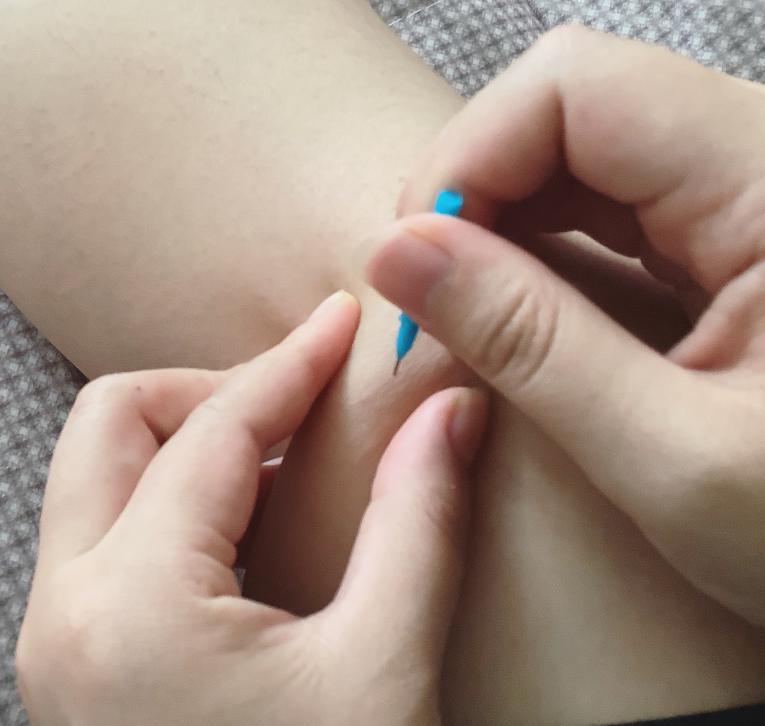Bloodletting Therapy
1
⊱ Introduction⊰
Bloodletting therapy is a method of external treatment in Traditional Chinese Medicine (TCM) that involves puncturing the skin with a three-edged needle or a disposable injection needle to release a small amount of blood from superficial small veins, specific acupoints, the site of lesions, or pathological reaction points on the body surface to treat diseases.

Bloodletting therapy has a long history, tracing back to the Paleolithic and Neolithic eras. Ancient people discovered that using sharp stones to puncture and release blood at the affected area could alleviate pain and treat certain diseases. This is what later generations referred to as bian stone. The Fifty-Two Disease Formulas contains records of using bian stones to incise abscesses, drain pus, and release blood for treatment.
As society developed and technology advanced, specialized needles for bloodletting therapy, known as “sharp needles”, emerged. The Huangdi Neijing states, “Bloodletting involves puncturing the small vessels to release blood,” and proposes the treatment principle of “when the blood is stagnant, it should be released to eliminate the bad blood.” The text contains 46 chapters elaborating on bloodletting therapy, indicating its popularity at that time.
2
⊱ Mechanism of Action ⊰
The therapeutic mechanism of bloodletting therapy primarily involves removing stagnant blood and other pathological products obstructing the meridians, achieving the goals of unblocking the meridians, harmonizing yin and yang, and eliminating diseases.
Modern research indicates that bloodletting therapy:
① Can reduce red blood cell aggregation, leading to an immediate decrease in blood viscosity, significantly improving microcirculation and enhancing local blood supply;
② Can inhibit inflammatory responses, releasing substances such as potassium ions and bradykinin, achieving the goal of removing stagnant blood and generating new blood;
③ Can regulate the secretion function of vascular endothelial cells by affecting blood flow shear stress, thereby strengthening vascular function and improving local microcirculation;
④ Can enhance the stress resistance of nerve cells, slow down apoptosis, and protect brain tissue from ischemic damage.
3
⊱ Clinical Applications ⊰
Bloodletting therapy is primarily applied to blood stasis syndrome, aiming to eliminate pathogens, relieve exterior conditions, clear heat, open orifices, remove stasis, and promote circulation. It is effective, has no side effects, and is widely used clinically. Common applications include fever, mania, malaria, coma, throat obstruction, pain syndromes, skin diseases, and joint diseases such as low back pain and knee pain.
Bloodletting therapy can also be used for patients with certain deficiency syndromes, with the aim of first removing stagnant blood to achieve yin-yang balance before tonifying deficiency. The founder of the “Earth Supplement School,” Li Dongyuan, was adept at using bloodletting therapy to treat deficiency syndromes. In his work On the Spleen and Stomach, he mentions treating atrophy syndrome by stating, “Use a three-edged needle to draw blood from the Sanli (ST36) point; if sweating occurs and does not stop, draw blood from the point three inches below Sanli,” reflecting the idea of using bloodletting to supplement deficiency.
4
⊱ Precautions ⊰
1. Communicate fully with the patient before bloodletting to alleviate their anxiety.
2. Bloodletting is not advisable for patients who are hungry, anxious, overworked, or sweating profusely.
3. The needles used must be strictly sterilized to avoid infection.
4. Monitor the patient’s physical condition and reactions during the bloodletting process.
5. Avoid getting the area wet for 24 hours after bloodletting.
6. This method is contraindicated for pregnant women, postpartum women, individuals with weak constitutions, and those who faint at the sight of needles or blood.
7. Patients with infectious diseases, anemia, or poor coagulation function should not use this method.
Note: Bloodletting therapy has specific requirements for needles, techniques, and the treatment environment! If needed, please visit a reputable hospital for treatment and seek professional medical assistance; do not attempt to perform it yourself!
References:
[1] Yang Li, Yuan Xiuli. Discussion on the Mechanism and Research Progress of Bloodletting Therapy [J]. Asia-Pacific Traditional Medicine, 2016, 12(02): 67-69.
[2] Chen Geng. The Theory and Application of Bloodletting in the Neijing [J]. Jilin Traditional Chinese Medicine, 2008(06): 461-462.
[3] Wu Jun, Shen Xiaorou. A Comparative Observation of Microcirculation Changes Before and After Bloodletting Treatment in 33 Cases [J]. Chinese Acupuncture, 2001(09): 42-43.
[4] Niu Qian, Liu Ligong, Liang Zijun. Immediate Effects of Hemorheological Indicators During Bloodletting [J]. Shanghai Acupuncture Journal, 2011, 30(07): 477-478.
[5] Zheng Xiaobin, Zhu Qiguang, Lin Yuanfang, Liu Tiexin. The Effect of Bloodletting Therapy on Stroke and Aphasia and Its Impact on Vascular Endothelin [J]. Hubei Traditional Chinese Medicine Journal, 2010, 32(09): 20-21.

Scan the QR code | Follow us
The WeChat public account of “Professor Bai Peng, a renowned acupuncture expert” is a public platform aimed at popularizing health knowledge for patients. If there are any inappropriate content or illustrations in this article, please contact us promptly, and we will address it immediately. Thank you for your efforts in public welfare!
Some illustrations and cover images in this article are sourced from the internet; if there is any infringement, please contact us for removal.

